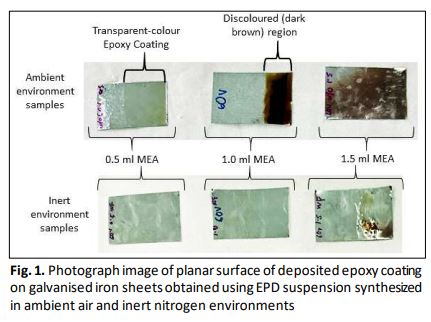Dielectric Property of Epoxy Coating Deposited using Electrophoretic Deposition Suspension Synthesised under Ambient and Inert Atmospheres
DOI:
https://doi.org/10.37934/armne.24.1.3545Keywords:
Electrophoretic deposition, dielectric property, DGEBA, epoxy resin, cationisation, functionalization, secondary amineAbstract
This study investigates the implications of N-methylethanolamine (MEA) concentrations and electrophoretic deposition (EPD) suspension synthesised under ambient air atmosphere and inert nitrogen gas environment on the chemical composition and dielectric properties of epoxy coatings. Cationised epoxy resin suspensions were synthesised from the modification of commercially available diglycidyl ether bisphenol A (DGEBA) epoxy using different MEA concentrations under ambient air and inert nitrogen gas environments. The cationic DGEBA suspension was then used in the EPD process to deposit an epoxy coating on a galvanised iron sheet. After elevated temperature curing, the epoxy coatings were characterised by Electrochemical Impedance Spectroscopy (EIS), Fourier-transform Infrared Spectroscopy (FTIR), Field-emission Scanning Electron Microscopy (FESEM), and Energy Dispersive Spectroscopy (EDS) analysis. The epoxy solution synthesised under the inert nitrogen gas environment produced an epoxy coating with a chemical composition identical to that of the as-received DGEBA functional groups. In contrast, the chemical composition of the epoxy coating synthesised under the ambient air environment displayed different chemical functional groups, suggesting a different chemical composition. For the ambient sample group, an increase in MEA concentration results in an increase in coating thickness and dielectric constant. In contrast, a similar change in the MEA level results in a decrease in epoxy thickness and dielectric constant.
Downloads




















